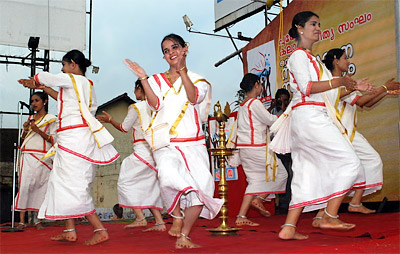 Margam Kali dance is a traditional folk dance popular in the Kerala state of India. This dance is performed by both men and women. The art was developed for propagating the Christian religious ideas among the people. The real source of inspiration for the performance of Margam Kali was Kalaripayattu, which was very popular when the Christian community had developed the form. The popularity of Margam Kali dance is quite sound. It is performed on various festive occasions and also during the time of marriage. Margamkali is often presented as a stage item today. It is included in the cultural shows of the schools and colleges as a competition item.
Margam Kali dance is a traditional folk dance popular in the Kerala state of India. This dance is performed by both men and women. The art was developed for propagating the Christian religious ideas among the people. The real source of inspiration for the performance of Margam Kali was Kalaripayattu, which was very popular when the Christian community had developed the form. The popularity of Margam Kali dance is quite sound. It is performed on various festive occasions and also during the time of marriage. Margamkali is often presented as a stage item today. It is included in the cultural shows of the schools and colleges as a competition item.
History of Margam Kali
The meaning of `Margam` is path or way. But in the religious context, it has a different meaning; here it is known as the path to attain salvation. The process of conversion to Christianity was known as "Margam Koodal" until recently in Kerala. The theme of the songs revolves around the life of St. Thomas and his contribution.
The original Margam Kali dance describes the arrival of St. Thomas in Malabar, the miracles he performed, the friendship as well as the hostility of the people among whom he worked, the persecution he suffered, the churches and crosses he put up in various places, etc. The Margam Kali songs describe all these details about him.
Performance of Margam Kali Dance
Margam Kali dance is performed in a group. This dance consists of several other group dances and martial arts like Parichamuttu Kali. The dancers perform this in a circle around a lighted oil lamp while singing songs. The lamp represents Christ and the performers are his disciples. The leader of the troupe or tutor, known as `Asan`, leads the song and the group repeats the same. The language used in the songs of Margam Kali reveals its relation with the old Tamil form.
The dance is usually performed in two parts narrating the life of St. Thomas, the apostle. It then takes a striking turn with a martial play of artificial swords and shields. Musical instruments are rarely used in this dance; it mainly depends on the lyrics of the song. The person who sings the song just uses two small palm size cymbals to accompany the rhythm of the dance. In the early days, only men used to perform Margam Kali dance but now women too have started participating. Margam Kali dance requires proper costumes for the performance. The dancers adorn themselves by wearing traditional white dhoti called "mundu" and blouse called "chatta".



















